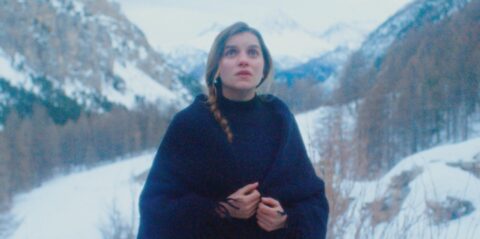The Girl in the Snow (Louise Hémon, 2025) is the type of classically-made work of art that at first feels like it could’ve been released perhaps any time in the last 50 years. Telling the story of a young republican woman named Aimée (Galatéa Bellugi) at the turn of the 20th century as she works for a schoolteacher in a remote village in the French Alps, it’s characterised by a careful tone in filmmaking, gorgeous nature photography and the eternal clash between tradition and enlightenment.
Yet, beneath the glacial aesthetics and familiar period markers is a smart, ever-shifting tone that makes you doubt the true intentions of the haughty schoolmaster, her lofty aims hidden under multiple layers of ambiguous cinematic ambition.
Galatéa Bellugi is perfectly cast as an idealist far away from home, educating the grandchildren of the locals as their parents, especially women, work in the valley below as servants. Her piercing blue eyes and direct stare, as well as a slight warmth in her smile, betray a severity of purpose as well as masked intentions. Due to her beauty and youth, she is immediately the talk of the town, with local men often eyeing her up like the goats on the mountaintops.
Almost immediately, her ideals come into conflict with the locals when she washes the local schoolchildren and the elders believe that she is exposing them to sickness. But this conflict doesn’t progress down the usual lines — certainly not the way you might expect in the neo-colonial Turkish cinema of Nuri Bilge Ceylan and his contemporaries — with Hémon bringing to mind the specificity and lighting of Robert Eggers as well as the long take, multi-level revisionism at the heart of Robert Altman’s 1971 masterpiece McCabe & Mrs. Miller.
Don’t watch this film with boomers. They will invariably complain that it is “shot in the dark” and either get their phone torches out or ask you to watch something else. But it’s a little more complicated than that, with the use of natural light both the film’s best asset and its biggest curse. For example, during an early scene where she is humiliated by the locals, only her face is illuminated by firelight while the others are seen almost in full profile. Later on, when she leaves the same house and berates the locals for their ignorance, the scene is in almost complete darkness, showing how her mission feels almost hopeless. Yet, at other times, the extremely dark scenes can make it frustratingly difficult to see what is going on. My recommendation would be to watch this on the best, clearest sceen you can.
But this is all on purpose as the day scenes are remarkably clear, the alpine valley shot with picture-postcard prettiness. The snow is its own character here, as essential to the plot as the all-white aesthetics of My Night At Maud’s (Éric Rohmer, 1969) or The Hateful Eight (Quentin Tarantino, 2015). If anyone were to die in this snow, their body would not be found until the spring. It’s an obvious metaphor for the way that secrets in this village often remain buried, but not forever. Eventually, a thaw will come.
Redmond is the editor-in-chief of Journey Into Cinema.

